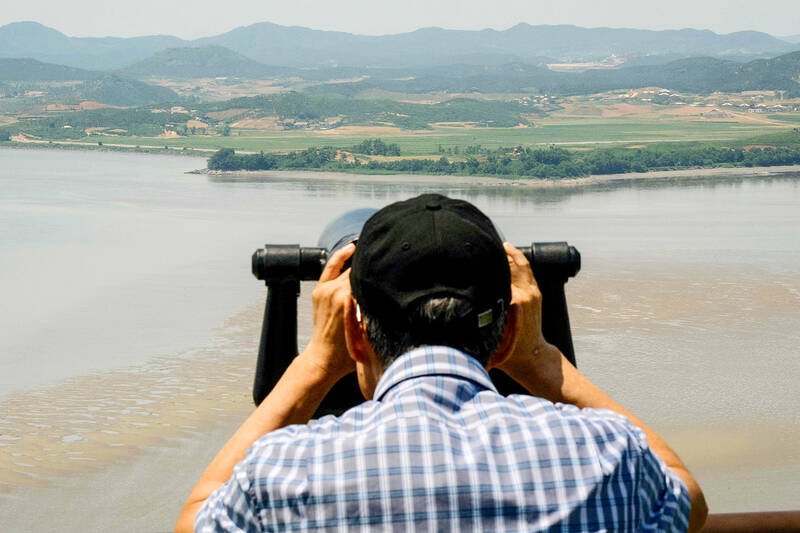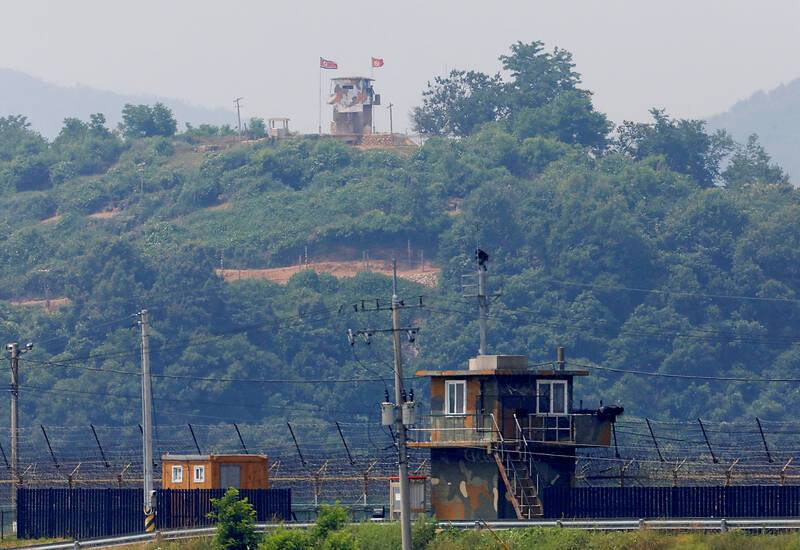Standing on top of a small mountain, Kim Seung-ho gazes out over an expanse of paddy fields glowing in their autumn gold, the ripening grains swaying gently in the wind. In the distance, North Korea stretches beyond the horizon.
“It’s so peaceful,” says the director of the DMZ Ecology Research Institute. “Over there, it used to be an artillery range, but since they stopped firing, the nature has become so beautiful.”
The land before him is the demilitarized zone, or DMZ, a strip of land that runs across the Korean peninsula, dividing North and South Korea roughly along the 38th parallel north.

Photo: AFP
This heavily fortified border was created after the devastating Korean war, which lasted from 1950 to 1953. The conflict ended in an armistice rather than a peace treaty, establishing a buffer zone between the two countries that remain in a technical state of war.
Stretching 250km across the peninsula and 3.8km wide, the DMZ is anything but demilitarized. It remains one of the world’s most heavily fortified borders, strewn with landmines and flanked by military installations on both sides.
Yet, in the 72 years since the war ended, this forbidden strip has become an accidental ecological paradise.

Photo: Reuters
South Korea’s National Institute of Ecology has documented nearly 6,000 species here, including more than 100 endangered species — representing more than a third of South Korea’s threatened wildlife.
The zone’s varied terrain creates distinct habitats: the wetlands of the western sector shelter migrating cranes, while the rugged eastern mountains provide sanctuary for some of the country’s most threatened mammals, including Siberian musk deer and Asiatic black bears.
Kim and his small team of volunteers, working from their research institute in Paju, near the North Korean border, have spent two decades documenting this unexpected sanctuary. Each week, come rain or shine, they survey the Civilian Control Zone (CCZ), the restricted buffer area bordering the DMZ.

Photo: AFP
“In temperate climates worldwide, big cities have developed,” he says. “There’s nowhere else where nature has been left alone like this.”
The DMZ and its surrounding areas, while covering less than 10 percent of South Korea’s total land area, harbor 38 percent of the country’s endangered species and more than 30 percent of its flora and fauna. This ecological miracle, however, comes with a dark twist.
“I used to think I was the best environmentalist,” Kim says, “but I realized the landmines are doing more for conservation than anyone. It’s ironic, no? Weapons meant for killing have become the greatest protectors of life.”
Kim’s team has meticulously documented every important species they encounter, building a detailed database of the region’s wildlife.
They map each sighting’s location, tracking how species move and habitats change over time. Their meticulous documentation has become invaluable.
“At government meetings, researchers sometimes hesitate to speak when we’re present,” Kim says. “They know our data is more comprehensive and accurate than official records.”
Despite its ecological richness, researching the DMZ is fraught with challenges. The zone itself remains off-limits to most civilians, heavily guarded and lined with military installations.
On its southern side lies the CCZ, where access is tightly restricted. Civilians must pass through military checkpoints, requiring special clearance from the defense ministry and, in certain areas, military escorts.
During our drive towards one of the few crossing points leading to the DMZ, Kim remarks that we are fortunate to have been granted access.
“Usually, when relations are this strained, civilian access is the first thing to be restricted,” he says.
Moments later, a phone call from the defense ministry informs us that our clearance has been revoked due to sudden military activity at the border.
“This is the reality we work in,” Kim sighs as we turn back and go to survey a nearby non-militarized spot. “One moment we’re planning research; the next, the military situation changes, and everything is put on hold.”
It is a frustrating setback, but one Kim’s team has grown used to. Later, it emerged that North Korean military personnel had approached the demarcation line to plant explosives, before blowing up the last remaining roads connecting the two countries.
It is a stark reminder that while hostilities officially ended in 1953, the tensions remain very real.
These setbacks underscore a more profound concern: both war and peace pose a threat to the delicate haven that has emerged in the DMZ. Kim fears that any peace agreement could bring development, threatening the fragile ecosystem.
“The current generation shouldn’t decide the DMZ’s fate,” he argues. “We should leave that to a generation that values biodiversity. They should choose its future.”

US President Donald Trump may have hoped for an impromptu talk with his old friend Kim Jong-un during a recent trip to Asia, but analysts say the increasingly emboldened North Korean despot had few good reasons to join the photo-op. Trump sent repeated overtures to Kim during his barnstorming tour of Asia, saying he was “100 percent” open to a meeting and even bucking decades of US policy by conceding that North Korea was “sort of a nuclear power.” But Pyongyang kept mum on the invitation, instead firing off missiles and sending its foreign minister to Russia and Belarus, with whom it

When Taiwan was battered by storms this summer, the only crumb of comfort I could take was knowing that some advice I’d drafted several weeks earlier had been correct. Regarding the Southern Cross-Island Highway (南橫公路), a spectacular high-elevation route connecting Taiwan’s southwest with the country’s southeast, I’d written: “The precarious existence of this road cannot be overstated; those hoping to drive or ride all the way across should have a backup plan.” As this article was going to press, the middle section of the highway, between Meishankou (梅山口) in Kaohsiung and Siangyang (向陽) in Taitung County, was still closed to outsiders

Many people noticed the flood of pro-China propaganda across a number of venues in recent weeks that looks like a coordinated assault on US Taiwan policy. It does look like an effort intended to influence the US before the meeting between US President Donald Trump and Chinese dictator Xi Jinping (習近平) over the weekend. Jennifer Kavanagh’s piece in the New York Times in September appears to be the opening strike of the current campaign. She followed up last week in the Lowy Interpreter, blaming the US for causing the PRC to escalate in the Philippines and Taiwan, saying that as

The Chinese Communist Party (CCP) has a dystopian, radical and dangerous conception of itself. Few are aware of this very fundamental difference between how they view power and how the rest of the world does. Even those of us who have lived in China sometimes fall back into the trap of viewing it through the lens of the power relationships common throughout the rest of the world, instead of understanding the CCP as it conceives of itself. Broadly speaking, the concepts of the people, race, culture, civilization, nation, government and religion are separate, though often overlapping and intertwined. A government